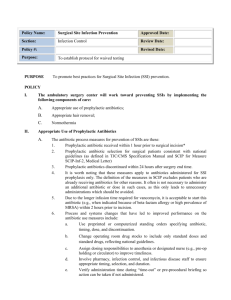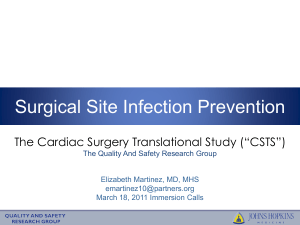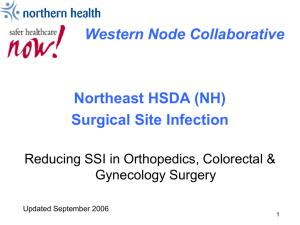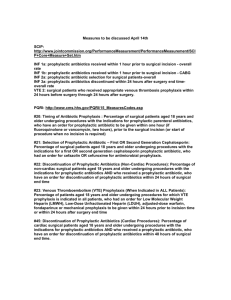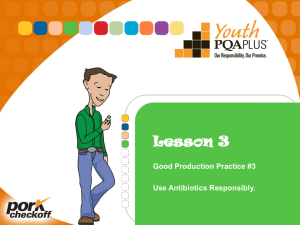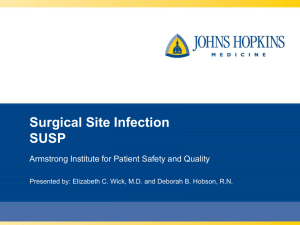Improvement Charter Template
advertisement
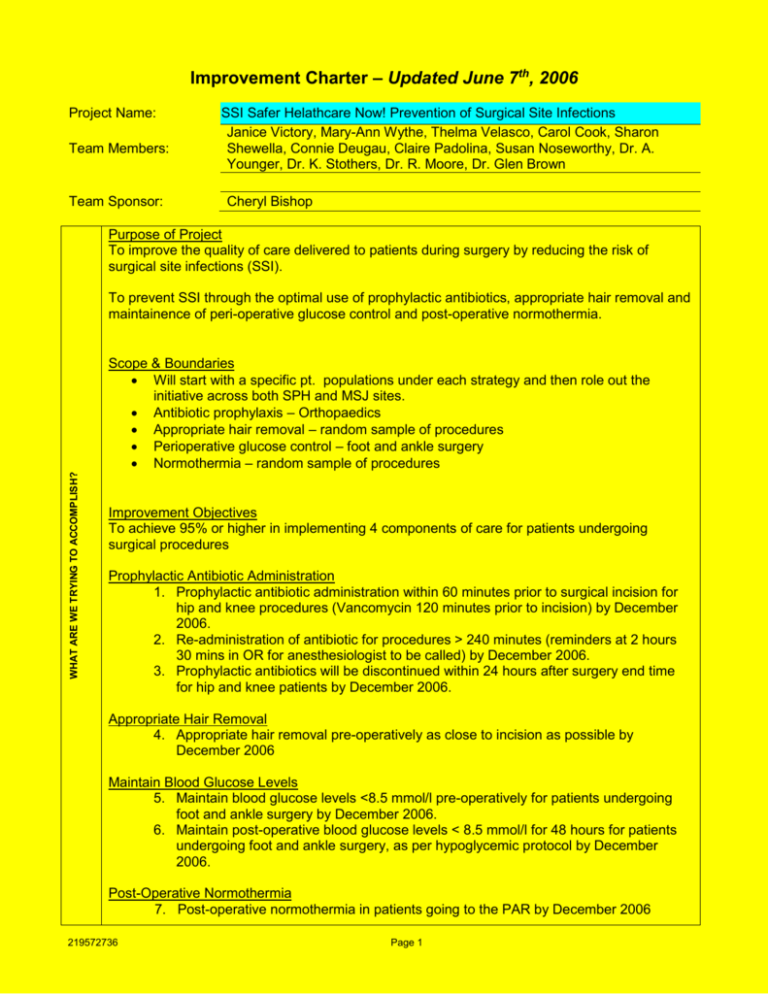
Improvement Charter – Updated June 7th, 2006 Project Name: Team Members: Team Sponsor: SSI Safer Helathcare Now! Prevention of Surgical Site Infections Janice Victory, Mary-Ann Wythe, Thelma Velasco, Carol Cook, Sharon Shewella, Connie Deugau, Claire Padolina, Susan Noseworthy, Dr. A. Younger, Dr. K. Stothers, Dr. R. Moore, Dr. Glen Brown Cheryl Bishop Purpose of Project To improve the quality of care delivered to patients during surgery by reducing the risk of surgical site infections (SSI). To prevent SSI through the optimal use of prophylactic antibiotics, appropriate hair removal and maintainence of peri-operative glucose control and post-operative normothermia. WHAT ARE WE TRYING TO ACCOMPLISH? Scope & Boundaries Will start with a specific pt. populations under each strategy and then role out the initiative across both SPH and MSJ sites. Antibiotic prophylaxis – Orthopaedics Appropriate hair removal – random sample of procedures Perioperative glucose control – foot and ankle surgery Normothermia – random sample of procedures Improvement Objectives To achieve 95% or higher in implementing 4 components of care for patients undergoing surgical procedures Prophylactic Antibiotic Administration 1. Prophylactic antibiotic administration within 60 minutes prior to surgical incision for hip and knee procedures (Vancomycin 120 minutes prior to incision) by December 2006. 2. Re-administration of antibiotic for procedures > 240 minutes (reminders at 2 hours 30 mins in OR for anesthesiologist to be called) by December 2006. 3. Prophylactic antibiotics will be discontinued within 24 hours after surgery end time for hip and knee patients by December 2006. Appropriate Hair Removal 4. Appropriate hair removal pre-operatively as close to incision as possible by December 2006 Maintain Blood Glucose Levels 5. Maintain blood glucose levels <8.5 mmol/l pre-operatively for patients undergoing foot and ankle surgery by December 2006. 6. Maintain post-operative blood glucose levels < 8.5 mmol/l for 48 hours for patients undergoing foot and ankle surgery, as per hypoglycemic protocol by December 2006. Post-Operative Normothermia 7. Post-operative normothermia in patients going to the PAR by December 2006 219572736 Page 1 HOW WILL WE KNOW A CHANGE IS AN IMPROVEMENT? Measures Prophylactic Antibiotics 1. Percentage of surgical pts. whose antibiotics were ordered on Physician Order sheet. 2. Percentage of surgical pts. With antibiotic administration within 60 minutes prior to surgical incision (Vancomycin two hours prior to incision) 3. For those cases > 240 minutes the percentage of surgical pts. whose antibiotics were readministered 4. Percentage of surgical pts. whose antibiotics were discontinued within 24 hours after surgery end time. (Cardiac 48 hours post-op) Appropriate Hair Removal 5. Percentage of surgical patients with appropriate hair removal Maintain Blood Glucose Levels (identify further process measures) 6. Percentage of patients whose blood glucose levels <8.5 mmol/l preoperatively for patients undergoing foot and ankle surgery. 7. Percentage of patients whose post-operative blood glucose levels were < 8.5 mmol/l for 48 hours for patients undergoing foot and ankle surgery Normothermia - SPH 8. Percentage of patients with post-op temperature in PAR >= 36.0 degrees Celsius 219572736 Current Performance Goals 1. N/A 1. 95% or higher 2. 2. 95% or higher 3. 3. 95% or higher 4. 4. 95% or higher 5. MSJ = 5/29 = 17.24% SPH = 47/51 = 92.0% *Those with hair removal by clippers 5. 95% or higher 6. 6. 95% or higher 7. 7. 95% or higher 8. 96% achieved (24/25) 8. Page 2 95% or higher WHAT CHANGES CAN WE MAKE THAT WILL RESULT IN IMPROVEMENT? Change Concepts and Ideas to Test Prophylactic Antibiotics Physician Pre-Op Orders – to ensure that antibiotic is ordered in clinic prior to surgery Timing – anesthesiologist to give antibiotics (in OR – process working as is) Process to flag charts with pre-op antibiotic orders Design a protocol to outline appropriate antibiotic administration Antibiotic post-op discontinuation orders Review possibility of having SDC stock of antibiotics and stock in OR’s for re-dosing Time outs to discuss whether administration of antibiotics As changes spread need to review clinical pathways to ensure antibiotic orders are included Appropriate Hair Removal Removed razors from the OR at MSJ Develop PHC protocol on appropriate hair removal practices Education to surgeons and staff on appropriate clipping practices Review process of hair removal Glucose Control Pre-surgery assessment tool Normothermia Baseline data showed that target (96%) is being met therefore we will not focus on this strategy at the present time. Random audits should continue to ensure target is being met. HOW WILL WE MANAGE THE IMPROVEMENT PROJECT? Other Ideas Communication strategy – to post best practice, audit results and accomplishments in ORs/units Key Dates: SSI Schedule of Events May 9th, 2006 – 9:00 to 10:00am SSI Monthly Collaborative Call (Janice listened in) May 25th, 2006 – 11:00 – 12:00 SSI Tracking Call (Villa) (Janice listened in) June 6th, 2006 – 9:00 to 10:00am SSI Monthly Collaborative Call June 19th and 20th, 2006 – Learning Session 2 (Vancouver, BC) June 27th, 2006 – 9:00 to 10:00am SSI Monthly Collaborative Call October 2nd and 3rd – Learning Session 3 (Penticton, BC) Roles & Responsibilities (3 working groups established to meet objectives) Mary-Ann Wythe – Lead, Antibiotic Prophylaxis Initiative Janice Victory – Lead, Perioperative Glucose Control Sharon Shewella/Carol Cook – Co-leads, Appropriate Hair Removal Susan Noseworthy – Qualtiy Improvement Specialist Documentation of Progress: Collaborative monthly report and central measurement team Project Tracker (updated monthly) 219572736 Page 3 219572736 Page 4
